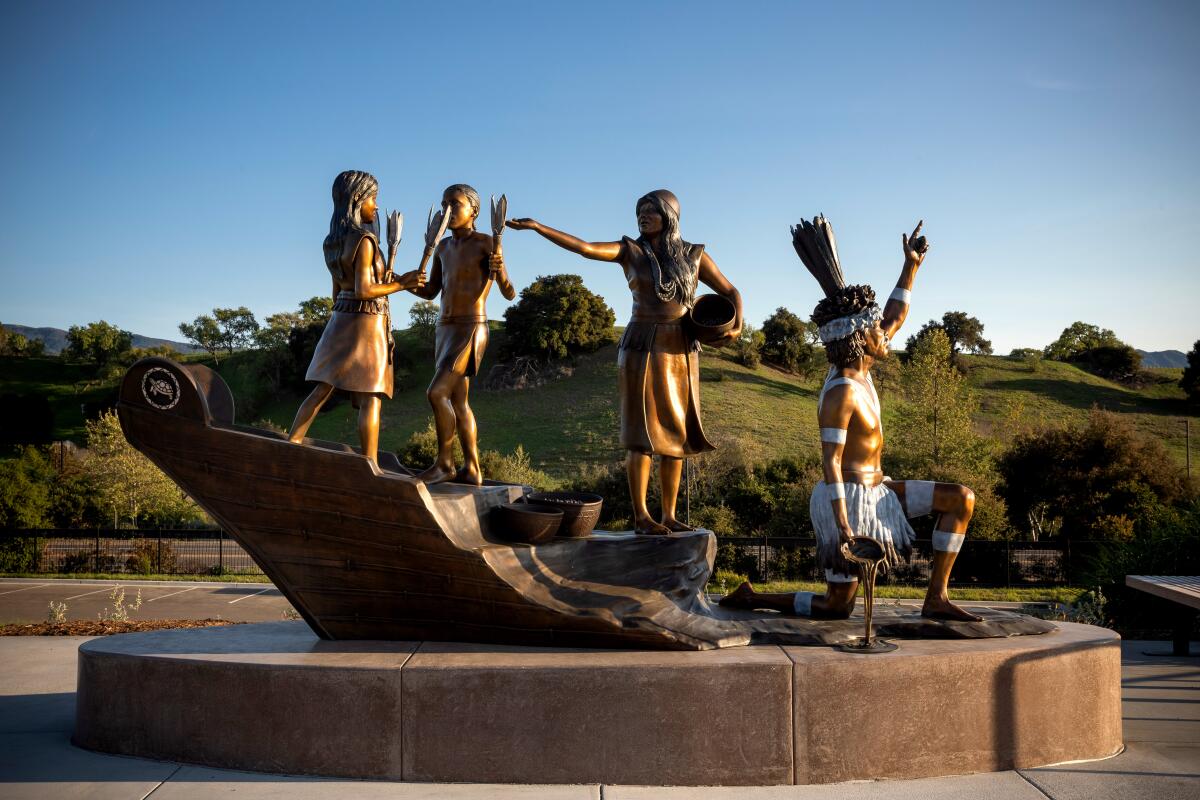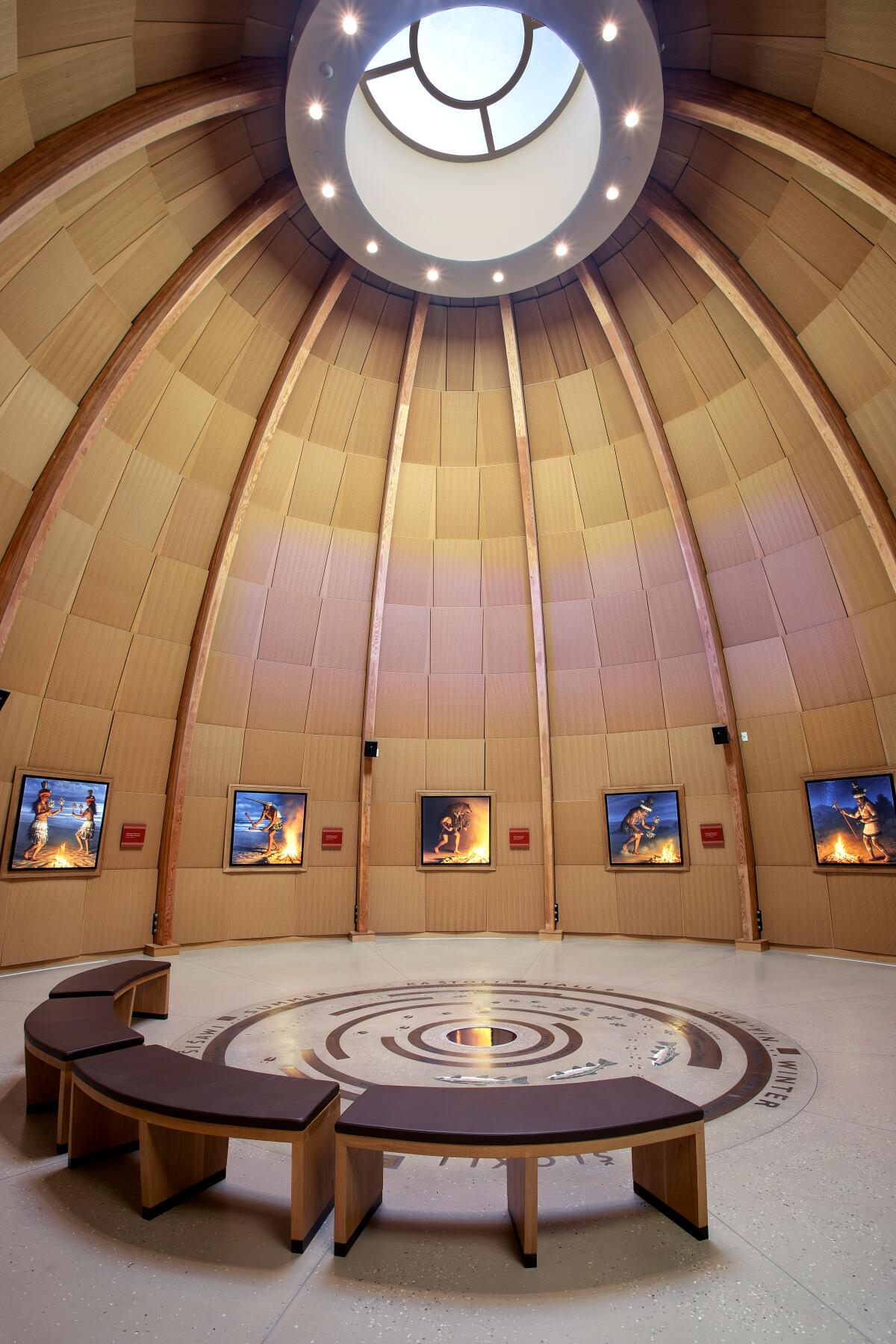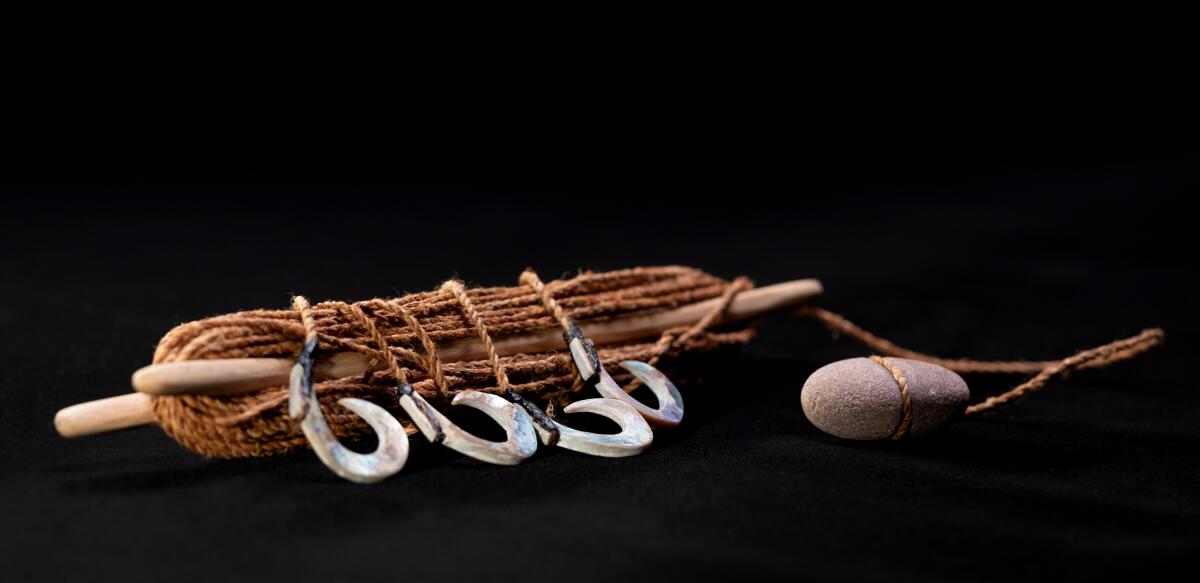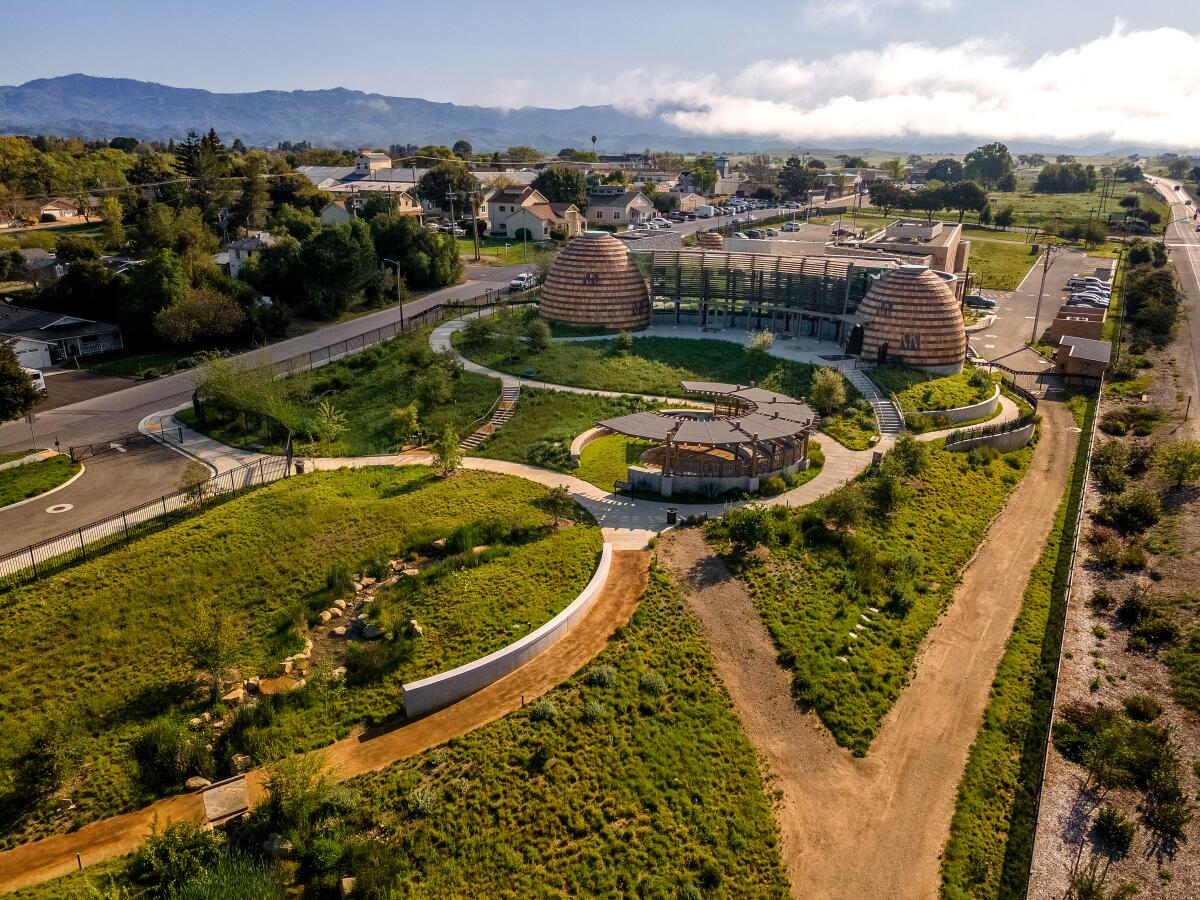Sign up for The Wild
We’ll help you find the best places to hike, bike and run, as well as the perfect silent spots for meditation and yoga.
You may occasionally receive promotional content from the Los Angeles Times.

For thousands of years, the Chumash people lived along California’s Central Coast and on its Channel Islands. Then the newcomers arrived — Spanish explorers, Catholic missionaries, Mexican rancheros, California settlers — and the Chumash way of life was dismantled, their people enslaved and their traditions, culture and language forbidden.
So it’s hardly surprising that the main message at the new Santa Ynez Chumash Museum and Cultural Center is as poignant as it is defiant: “We are the first people. And we are still here.”

The museum, which opened in May, sits on Highway 246 and Edison Street in tiny Santa Ynez, just across the road from Chumash Casino Resort operated by the Santa Ynez Band of Chumash Indians. But where the resort is a sleek, modern high-rise, the low-lying museum and lushly landscaped grounds are dedicated to the past, showcasing the stories, craftsmanship and even the plants of the Chumash, whose bands ranged along the coast from Malibu to Morro Bay and as far inland as the San Joaquin Valley, said Nakia Zavalla, the tribal historic preservation officer and cultural director of the Santa Ynez band.
As you walk past the shops on Sagunto Street, you’d be forgiven for thinking you hear your spurs jangling.
While the focus is on the past, however, the museum’s storytelling is high-tech, with lots of interactive displays that activate with just the wave of a hand. The tribe doesn’t permit photos inside the museum, and the few photos provided for publication don’t really do the exhibits justice, so believe me when I say the displays are far more engaging than just shelves of artifacts and well worth a visit for adults and children.
From the large parking lot, the path to the entrance winds along a man-made recirculating stream lush with spiky, deep-green mounds of deergrass (Muhlenbergia rigens), feathery sandbar willow (Salix exigua) and a variety of juncus such as basket rush (Juncus textilis), used for making the tribe’s intricate baskets. The 3.5-acre grounds as well as the museum itself were designed by Jones & Jones Architects of Seattle, which also designed the Smithsonian National Museum of the American Indian in Washington, D.C.
The main entrance is visually stunning, bringing visitors inside a larger-than-life “ap” (pronounced ahp), a towering representation of the traditional Chumash dwellings made from willow branches and dried leaves of tule plants, such as hardstem bulrush (Schoenoplectus acutus), which also grows on the grounds. The museum’s entry is like a giant dome with a big round skylight at the top. The large, sloping walls feature projections of birds taking flight and sparks rising from the faux firepit in the center of the room, along with detailed illustrations recognizing the region’s Chumash bands.

Inside, the exhibits are arranged in a meandering flow (just follow the blue line) that introduces visitors to a large and engaging range of interactive displays and stories, many of which were provided by elder Maria del Refugio Solares, Zavalla’s “fifth great-grandmother” and one of the last native speakers of the Chumash language Samala. Some tribal members are trying to resurrect Samala through classes and “just getting together and speaking with each other,” said Zavalla. “It’s opened so many doors to understanding our culture, our medicinal plants and ceremonies.”
Solares died in 1923 at 81, but left wax cylinder recordings of Chumash songs, stories and translations with linguist and Native American language ethnologist John Peabody Harrington. Incorporating Solares’ songs and stories makes the exhibits come alive.
For instance, near the beginning of the permanent exhibit there is a cave-like room explaining the Chumash understanding of the universe, which is divided into three levels. The upper world is inhabited by celestial Sky People, such as Sun and Sky Coyote, whose peón gambling games affected the seasons for everything from harvesting acorns to hunting game. The dark, eerie lower world is dominated by two giant rattlesnakes whose writhings cause the ground in the middle world — our world — to shake.
The recently opened Cheech Marin Center for Chicano Art and Culture is an essential repository of recent art history.
The phases of the moon? Those are caused by the way Slo’w, the Sky Eagle, stretches his wings. Thunder? The result of two brothers in the Upper World playing a rowdy stick game.
Nearby, an alcove features a preserved California condor known as AC8, the last female in the wild who was taken into captivity in 1986 to become part of a breeding program to rebuild the critically endangered population of North America’s largest land bird. In the exhibit, you must look up to see her, preserved as if in flight, her massive wings outstretched, while below is a miniature depiction of the local hills with a small gliding shadow of a condor in flight.
Further on are hunting outfits made from deer and bear heads and skins, examples of traditional Chumash stick and gambling games, and stuffed animals for children that were — literally — dead, cuddly rabbits carefully preserved. There are exquisite medallions and hair ornaments made from iridescent abalone shells and strings of Chumash currency — tiny, doughnut-shaped beads created from carefully cut olivella shells.

And of course, there are multiple examples of Chumash basket weaving, from the tightly woven vessels used to hold food and even water to the carriers designed to securely tote babies. The museum includes more recent history as well, such as the startling news that running water wasn’t available on the reservation until 1969.
Outside, in the 3.5-acre cultural park, you can follow a winding trail through the Ancestor’s Grove — young coast live oak trees, each with a marker honoring a deceased tribal elder — to view the long redwood plank canoe known as a tomol, big enough to seat at least six adults and used annually to re-create the trips their ancestors made between the mainland and the Channel Islands. The park also features another recirculating stream and 100 species of native plants that would have provided food, shelter and habitat in the region before the explorers and colonists arrived.
The landscape is constantly changing, said Megan Carey, the museum’s collections and archives manager. “One of my favorite things about the Culture Park is that you see something different, something blooming, every week.”

The Santa Ynez Chumash Museum and Cultural Center is open Thursday-Sunday, from 10 a.m. to 5 p.m. Reserved-time tickets can be purchased online. Tickets are $15 for ages 18-64; $12 for ages 65 and older, teens 13-17, and military members with ID; $10 for ages 3-12; and free for toddlers 2 and younger. Tickets aren’t sold past 4 p.m. Parking is free.
The museum also has a well-stocked gift store near the parking lot, but for food, shopping and other excitement, you’ll need to venture into the sometimes rustic, sometimes well-heeled town of Santa Ynez, where you’ll find upscale clothing and furnishing stores that don’t cater to tourists as much as the monied locals outfitting themselves and, perhaps, second or third homes.
Here are other things to do in Santa Ynez but take note: Some restaurants are closed on Mondays.
Dining: I had an excellent roast beef sandwich (chosen from many tempting options) at Panino Sandwich Shop, but there are many other dining options. Locals highly recommended the Baker’s Table for bread, pastries, breakfast and lunch, and Brothers Restaurant at the Red Barn or Trattoria Grappolo for dinner. If you want a down-home atmosphere, try the Longhorn Coffee Shop for breakfast (it closes at 1 p.m. and the only coffee served is cowboy coffee, black); or for lunch, the nearby Maverick Saloon where the ceiling is papered by dangling dollar bills (children are welcome, they just can’t sit at the bar). Pony Cocktails & Kitchen boasts “all day cocktails and dining” starting at 8 a.m. (although it closes at 2:30 p.m. on Sundays and Mondays).
Coffee: Try Queen Cup Coffee (adjacent to a very cute Lucky Hen Larder sandwich and cheese shop.)
Make the drive up U.S. 101 and you can hear jazz in a snug basement club, sleep in a renovated mid-century motel or roar past vineyards in a motorcycle sidecar.
Shopping: Several tony options if you’re in the market for luxury home furnishings (such as very cool denim placements at $35 each) and/or designer clothing (Santa Ynez General offers both along with candles, soaps and toothpaste — and is a nice non-snooty place to browse). Charlotte’s Santa Ynez specializes in unique (and gorgeous) sterling silver and turquoise jewelry and belts, along with other Native American jewelry. And if your head is feeling naked, KJ Murphy’s promises a “premier custom hat experience” and choices that range from authentic cowboy hats to fedoras and trucker hats.
Out of the ordinary: In the center of town, the Santa Ynez Valley Historical Museum and Parks-Janeway Carriage House promises “the largest horse-drawn vehicle collection west of the Mississippi” including a stagecoach, farm wagon and fire engine in addition to examples of “regional saddlery, period apparel, and vintage horse gear.” And just a few miles down the road is Rancho Olivos, an 8-acre olive oil farm that offers an assortment of delicious olive oils, produced from their own olives, along with several vinegars. The balsamic vinegar is outstanding, and the Spanish-style Arbequina oil has a delicious, buttery flavor. I wish I had bought a dozen bottles, but now I have another excellent reason to return.
Sign up for The Wild
We’ll help you find the best places to hike, bike and run, as well as the perfect silent spots for meditation and yoga.
You may occasionally receive promotional content from the Los Angeles Times.